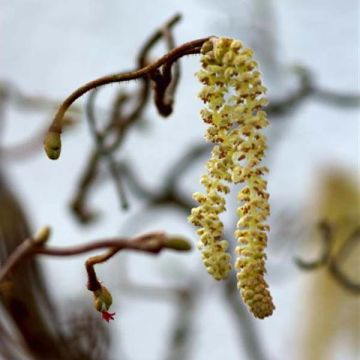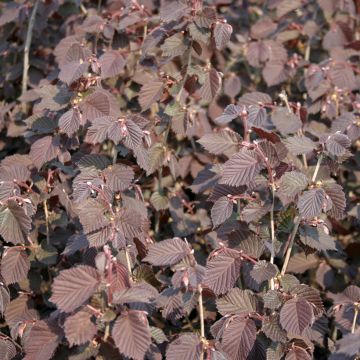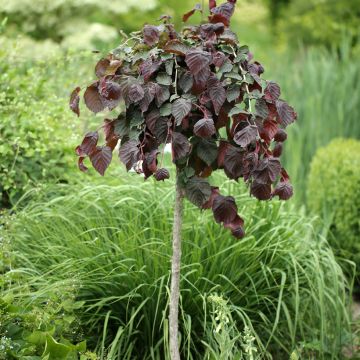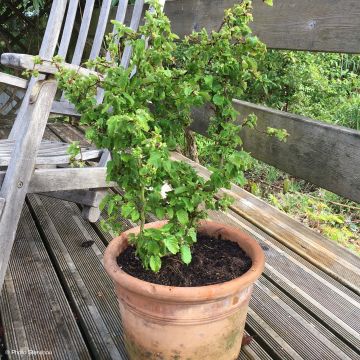

Corylus avellana Twister - Common Hazel
Corylus avellana Twister - Common Hazel
Corylus avellana Twister
Hazel, Common Hazel, European Hazel
Special offer!
Receive a €20 voucher for any order over €90 (excluding delivery costs, credit notes, and plastic-free options)!
1- Add your favorite plants to your cart.
2- Once you have reached €90, confirm your order (you can even choose the delivery date!).
3- As soon as your order is shipped, you will receive an email containing your voucher code, valid for 3 months (90 days).
Your voucher is unique and can only be used once, for any order with a minimum value of €20, excluding delivery costs.
Can be combined with other current offers, non-divisible and non-refundable.
Why not try an alternative variety in stock?
View all →This plant carries a 24 months recovery warranty
More information
We guarantee the quality of our plants for a full growing cycle, and will replace at our expense any plant that fails to recover under normal climatic and planting conditions.
Would this plant suit my garden?
Set up your Plantfit profile →
Description
Hazel or Corylus avellana 'Twister' is a dwarf variety of twisted hazel. It grows slowly, in a spiral, and forms a miniature tree with beautifully and regularly twisted and sinuous branches. In late winter, its branches are adorned with pretty elongated yellow catkins, before the leaves appear. These are green during the season and turn golden yellow in autumn. This very compact, small shrub can be grown in the ground or a pot on the terrace. Very hardy and adaptable, it tolerates all soils as long as they are not too dry or too shallow.
The Hazel tree, is a large fruit-bearing shrub of the Betulaceae family (like Birches, Hornbeams or Alders in the countryside). It is found throughout Europe, as well as in Russia and the Middle East. It is very common in woods and on the edge of forests, in moist, rich and deep soils. As early as the end of winter, between February and March, when their branches are still bare, hazels produce long decorative male catkins. They will pollinate the tiny female flowers that appear afterwards. The species is monoecious, meaning that the male and female flowers are separate but present on the same plant.
The 'Twister' hazel is a dwarf and twisted form, which reaches 1.5m in height and 1m in width after 10 years of cultivation and can eventually measure 2 to 3m in height. Hazels can form very large crowns over the years, but that will not be the case here, 'Twister' develops moderately and at a slow pace. Its branches contort themselves down to the finest twig, thus forming a particularly decorative scene. It becomes even more striking when the rain makes its beautiful copper-brown bark shine, or when snow or ice settles on the branches, emphasising their unique architecture. In February-March, before the leaves appear, the bare wood is adorned with numerous slender and narrow yellow catkins, about 5 centimetres long. These pendants then transform the shrub into a chandelier with fantastic shapes. The 5 to 10 cm long leaves, have a beautiful bright green colour throughout the growing season and then turn golden yellow in autumn to finish beautifully.
Plant 'Twister' in a bed near the house, so you can enjoy it from your window during winter as it is at its most beautiful when its branches are bare. You can associate it with other plants with winter interest, such as shrubs with decorative bark, such as the Common Dogwood, planted in the background because it is more vigorous, whose bright red bark strongly contrasts with the hazel's brown. Cornus stolonifera 'Flaviramea' with its yellow branches is also an excellent companion, as well as Rubus thibetanus 'Silver Fern', an ornamental bramble with very upright beautiful white branches. Also consider decorative fruits, such as those of Spindle Trees like Euonymus planipes, which also forms a wonderful scene in autumn with its flamboyant purple foliage against which the hazel's yellow foliage stands out. It can be easily grown in a pot to decorate a terrace or even a balcony.
Report an error about the product description
Plant habit
Flowering
Foliage
Safety measures
Botanical data
Corylus
avellana
Twister
Betulaceae
Hazel, Common Hazel, European Hazel
Cultivar or hybrid
atteinterespiratoire
Cette plante peut entraîner des symptômes allergiques.
Evitez de la planter si vous ou vos proches souffrez de rhinite saisonnière ("rhume des foins").
Davantage d'informations sur https://plantes-risque.info
Other Corylus - Hazelnuts
View all →Planting and care
Easy to grow and extremely hardy, the Twister Hazel will adapt to any good garden soil that is not too dry, without excessive limestone or acidity. If your soil is too compact, add compost at planting to lighten it a bit, mixed with the existing soil. Soak the root ball in a bucket of water for fifteen minutes to thoroughly saturate it before planting. This easy-to-grow bush thrives in a sunny to semi-shaded location.
Planting period
Intended location
Care
This item has not been reviewed yet - be the first to leave a review about it.
Similar products
Haven't found what you were looking for?
Hardiness is the lowest winter temperature a plant can endure without suffering serious damage or even dying. However, hardiness is affected by location (a sheltered area, such as a patio), protection (winter cover) and soil type (hardiness is improved by well-drained soil).

Photo Sharing Terms & Conditions
In order to encourage gardeners to interact and share their experiences, Promesse de fleurs offers various media enabling content to be uploaded onto its Site - in particular via the ‘Photo sharing’ module.
The User agrees to refrain from:
- Posting any content that is illegal, prejudicial, insulting, racist, inciteful to hatred, revisionist, contrary to public decency, that infringes on privacy or on the privacy rights of third parties, in particular the publicity rights of persons and goods, intellectual property rights, or the right to privacy.
- Submitting content on behalf of a third party;
- Impersonate the identity of a third party and/or publish any personal information about a third party;
In general, the User undertakes to refrain from any unethical behaviour.
All Content (in particular text, comments, files, images, photos, videos, creative works, etc.), which may be subject to property or intellectual property rights, image or other private rights, shall remain the property of the User, subject to the limited rights granted by the terms of the licence granted by Promesse de fleurs as stated below. Users are at liberty to publish or not to publish such Content on the Site, notably via the ‘Photo Sharing’ facility, and accept that this Content shall be made public and freely accessible, notably on the Internet.
Users further acknowledge, undertake to have ,and guarantee that they hold all necessary rights and permissions to publish such material on the Site, in particular with regard to the legislation in force pertaining to any privacy, property, intellectual property, image, or contractual rights, or rights of any other nature. By publishing such Content on the Site, Users acknowledge accepting full liability as publishers of the Content within the meaning of the law, and grant Promesse de fleurs, free of charge, an inclusive, worldwide licence for the said Content for the entire duration of its publication, including all reproduction, representation, up/downloading, displaying, performing, transmission, and storage rights.
Users also grant permission for their name to be linked to the Content and accept that this link may not always be made available.
By engaging in posting material, Users consent to their Content becoming automatically accessible on the Internet, in particular on other sites and/or blogs and/or web pages of the Promesse de fleurs site, including in particular social pages and the Promesse de fleurs catalogue.
Users may secure the removal of entrusted content free of charge by issuing a simple request via our contact form.
The flowering period indicated on our website applies to countries and regions located in USDA zone 8 (France, the United Kingdom, Ireland, the Netherlands, etc.)
It will vary according to where you live:
- In zones 9 to 10 (Italy, Spain, Greece, etc.), flowering will occur about 2 to 4 weeks earlier.
- In zones 6 to 7 (Germany, Poland, Slovenia, and lower mountainous regions), flowering will be delayed by 2 to 3 weeks.
- In zone 5 (Central Europe, Scandinavia), blooming will be delayed by 3 to 5 weeks.
In temperate climates, pruning of spring-flowering shrubs (forsythia, spireas, etc.) should be done just after flowering.
Pruning of summer-flowering shrubs (Indian Lilac, Perovskia, etc.) can be done in winter or spring.
In cold regions as well as with frost-sensitive plants, avoid pruning too early when severe frosts may still occur.
The planting period indicated on our website applies to countries and regions located in USDA zone 8 (France, United Kingdom, Ireland, Netherlands).
It will vary according to where you live:
- In Mediterranean zones (Marseille, Madrid, Milan, etc.), autumn and winter are the best planting periods.
- In continental zones (Strasbourg, Munich, Vienna, etc.), delay planting by 2 to 3 weeks in spring and bring it forward by 2 to 4 weeks in autumn.
- In mountainous regions (the Alps, Pyrenees, Carpathians, etc.), it is best to plant in late spring (May-June) or late summer (August-September).
The harvesting period indicated on our website applies to countries and regions in USDA zone 8 (France, England, Ireland, the Netherlands).
In colder areas (Scandinavia, Poland, Austria...) fruit and vegetable harvests are likely to be delayed by 3-4 weeks.
In warmer areas (Italy, Spain, Greece, etc.), harvesting will probably take place earlier, depending on weather conditions.
The sowing periods indicated on our website apply to countries and regions within USDA Zone 8 (France, UK, Ireland, Netherlands).
In colder areas (Scandinavia, Poland, Austria...), delay any outdoor sowing by 3-4 weeks, or sow under glass.
In warmer climes (Italy, Spain, Greece, etc.), bring outdoor sowing forward by a few weeks.





















































